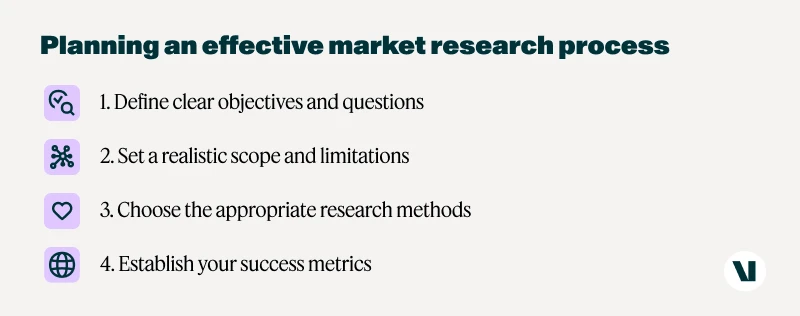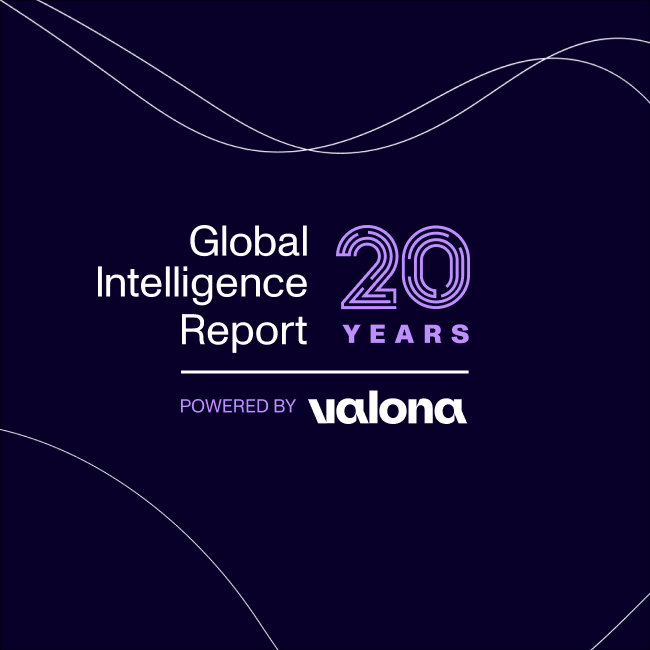
What is market research process? A practical guide
Learn the essential steps of the market research process from start to finish: how to define clear research questions and turn insights into business strategy.
Understanding your target market—what they want, how much they’re willing to pay, and how you compare to the competition—is crucial before bringing a new product or service to market. Market research helps you avoid potentially costly mistakes and develop offerings that truly meet your customers’ needs.
But for many companies, it’s tough to know when and how to get started.
Luckily, we’re here to make it a little clearer.
What modern market research really means
Market research is the process of gathering and analyzing data about your customers, competitors, and industry. It’s an essential tool for any business, providing the insights you need to make informed decisions.
- Understanding target market dynamics through validated data sources and primary research
- Analyzing industry trends and competitor movements using multiple trusted information streams
- Closing knowledge gaps through targeted information with primary research
- Gathering deep customer insights from both existing customers and potential buyers
- Identifying market opportunities and challenges through comprehensive analysis
- Validating business assumptions with reliable, unbiased data (e.g. comparing it to in-house research
Market research services has evolved far beyond simple customer surveys and data collection. Now, it’s about transforming raw information into strategic insights that drive better business decisions.
The foundation of effective research is simple but crucial: without clear questions, you won’t get clear answers.
The key difference between random data collection is purpose and process—market research should always be tied back to specific business objectives and follow a structured methodology.
The measurable impact of market research
Organizations that build a continuous market intelligence practice grow faster than their competitors. This advantage comes from several key capabilities that proper market research makes possible:
- Reduced business risk
Market research validates assumptions before major investments, helping companies avoid costly mistakes and identify potential challenges early. - Early opportunity identification: Systematic monitoring of market changes and emerging trends allows companies to act on opportunities before competitors notice them. In strategic foresight, we call this EWOS – Early Warning & Opportunity System.
- Customer-focused decision making: Regular gathering of customer insights ensures product development and business strategies align with actual market needs.
- Innovation in product development: Comprehensive market analysis reveals gaps in current offerings and unmet customer needs that can drive product development.
- Competitive advantage: A deep understanding of market position and competitor movements enables better strategic positioning and in turn, competitive advantage.
The most effective organizations don’t wait for specific needs to arise before conducting research. Instead, they build ongoing intelligence gathering into their standard business processes.
Market research vs. market intelligence
While often incorrectly used interchangeably, market research and market intelligence are quite different, and serve distinct but complementary purposes in business strategy:
Market research focuses on specific objectives:
- Answering defined business questions through targeted investigation
- Collecting primary data through surveys, interviews, and direct customer interaction
- Conducting time-bound studies for particular projects or decisions
- Analyzing specific market segments or business issues in depth
Market intelligence provides ongoing market understanding:
- Maintaining continuous monitoring of market movements and trends
- Integrating multiple data sources for comprehensive market views
- Providing broad market overview and competitive landscape analysis
- Tracking evolving trends and market changes in real time
The most effective approach combines both disciplines: market intelligence provides the continuous backdrop of understanding, while focused market research helps answer specific strategic questions.
Planning an effective market research process
The success of any market research project hinges on the initial planning phase.
Many organizations jump straight into data collection without proper preparation, leading to unfocused results that don’t serve their business objectives. Sometimes, companies make decisions (for example, a new product launch or market entry) and use market research to validate their decision-making.
As you can imagine, neither of the above methods are optimal ways of going about market research.

A starting point for your next market research process could look something like this:
Define clear objectives and questions
- Identify specific business challenges that need addressing
- Understand what different stakeholders need from the research
- Consolidate multiple information needs into clear research questions
- Stay focused rather than trying to gather all possible information
Set a realistic scope and limitations
- Start with a broad view before diving into specifics
- Define clear parameters for what will and won’t be covered
- Consider available resources and time constraints
- Plan for both immediate and long-term information needs
Choose the appropriate research methods
- Determine the right mix of desk research and primary research
- Consider which sources will provide the most reliable data
- Plan for ongoing validation across multiple sources
- Ensure methods align with objectives and available resources
Establish your success metrics
- Define what success looks like for your research project
- Set clear KPIs that align with business objectives
- Plan how results will be measured and validated
- Consider both quantitative and qualitative success indicators
Starting with a broad view before narrowing it down to specifics often brings about better results.
For example, when planning market entry into multiple countries, try resist the urge to analyze every potential market simultaneously. Instead, first determine what makes a market attractive for your business, then use those criteria to identify the most promising opportunities for deeper investigation.
Primary research and secondary research
Market research methods broadly fall into two categories: primary research (direct data collection) and secondary research (analysis of existing data). You’ll need to assess what mix of primary and secondary research best suits the research questions and budgets you’ve decided on.
Primary research: direct data collection
- Interviews with industry experts and customers
- Surveys and questionnaires
- Focus groups and workshops
- Field observations and trials
- Customer behavior analysis (e.g. in-product monitoring, website behavior monitoring, in-person behavioral analysis)
Secondary research: existing data analysis
- Industry reports and market studies
- Government databases and statistics
- Academic research papers
- Trade publications and news sources
- Competitor analysis and benchmarking
One often-overlooked source of valuable market intelligence? Your existing customers. Organizations frequently bypass this rich source of insights while searching for external data. Simple conversations with current customers can reveal crucial information about market needs, product improvements, and competitive positioning.
The validation imperative: ensuring reliable results
Validation isn’t a single step, rather, it’s an ongoing process throughout your research project. Here’s how to ensure your findings are both accurate and actionable:
Use multiple trusted sources
- Cross-reference information across different reliable sources
- Compare your findings from various research methods
- Validate your secondary research through primary research
- Challenge assumptions with data
Maintain continuous quality control
- Document data collection methods and sources
- Record any limitations or potential biases
- Keep clear records of validation steps
- Update findings as new information emerges
Focus on relevance
- Try to filter out noise and irrelevant information
- Stay aligned with research objectives, scope, and your market definitions
- Ensure findings connect to business goals
- Maintain focus on actionable insights
The above points are a lot to take in, we know. The good news is that the more research practice you get, the more natural it becomes to include these research best practices in your own.
Technology’s role in modern market research
As an AI-powered market intelligence solution, we know we’re biased, but technology has allowed our field to make incredible leaps in its efficiency, reliability, and accessibility.
However, while artificial intelligence and advanced analytics have transformed market research capabilities, we still believe technology should augment rather than replace human analysis (which is why many of our customers couldn’t live without our amazing research and consulting team!)
To sum it up, this is where we believe humans and artificial intelligence can work together most effectively:
AI and automation strengths
- Processing large volumes of data quickly
- Identifying patterns and trends
- Monitoring multiple sources simultaneously
- Translating and analyzing multilingual content
Human analyst strengths
- Making educated judgments about data relevance
- Providing context and strategic recommendations
- Keeping research focused on business objectives
- Drawing meaningful conclusions from complex information
The key is combining both: use technology to handle data collection and initial processing, while relying on human expertise for interpretation and strategic recommendations.
Specialized market research: going beyond the basics
Market sizing and forecasting
While perfect accuracy in market sizing remains elusive, companies can develop reliable market estimates through a combination of methodologies and clear assumptions. Top-down analysis begins with comprehensive market figures before systematically breaking them into relevant segments. Through logical assumptions and careful cross-validation, this method provides a strong initial framework for understanding market scale.
Bottom-up analysis takes the opposite approach, constructing market size estimates from individual components. This method accounts for industry capacity limits, regional variations, and specific market constraints. The most robust market sizing projects employ both approaches, using any discrepancies between the two methods to identify potential blind spots or faulty assumptions.
For example, when a manufacturing company needs to estimate the market size for a new product line, they might start with overall industry spending (top-down) while simultaneously calculating potential customer bases and average purchase values (bottom-up).
Comparing these results often reveals important market dynamics that neither method would capture alone.
Customer behavior research in B2B context
Modern B2B customer research surpasses traditional surveys and focus groups. Companies in industrial applications and other B2B sectors create frameworks that combine quantitative data with qualitative insights to understand their clients and build detailed customer profiles.
They focus on analyzing purchase decisions, examining factors that influence buying choices, map customer journeys, identify key decision points, and understand rational and emotional drivers. Companies must also recognize unique decision-making processes in different segments and markets.
Engaging directly with existing clients helps uncover unmet needs, assess satisfaction with services, and identify areas for improvement. This dialogue enables companies to test new concepts and launch new products or services effectively.
Companies gain deeper insights by observing how clients use products and services, instead of relying solely on feedback. This approach reveals opportunities for enhancement and innovation and typically involves multiple research methods, like direct observation and usage analytics, to achieve a comprehensive understanding.
Competitive analysis
Strong competitive analysis projectscombine systematic monitoring with strategic interpretation. Regular tracking of competitor movements provides the foundation, while periodic deep-dive analyses offer crucial strategic insights.
Successful companies monitor their competitors’ activities across multiple dimensions simultaneously. Product development trajectories, pricing strategies, and market positioning all provide important signals about competitive intent. Meanwhile, analysis of strategic investments and partnerships can reveal longer-term competitive directions before they become obvious in the marketplace.
The most sophisticated competitive analysis also examines underlying capabilities and constraints. Understanding competitors’ manufacturing capacity, distribution networks, and technological capabilities helps companies anticipate potential competitive moves and identify sustainable advantages.
One of the main challenges with competitive analysis is the sheer time investment required to make sure that competitor data is up to date.
Competitive intelligence platforms can remove the manual work aspect and ensure all competitor data is updated in real-time, helping you make the most informed decisions possible.
Common market research challenges
Strategic timing and resource allocation
Market research delivers maximum value when integrated into strategic planning from the beginning. Companies that wait until after key decisions are made often find themselves using research merely to validate existing choices rather than to inform strategic direction.
Intelligent organizations build research capabilities progressively, starting with fundamental market monitoring and adding more sophisticated analysis over time. This approach allows them to develop both the technical capabilities and organizational culture needed for effective research.
Resource constraints need not prevent effective research. Strategic focus on key questions, careful selection of research methods, and creative use of existing data sources can deliver valuable insights even with limited resources. The key lies in matching research scope to available resources while maintaining rigorous standards for data quality.
Managing information complexity
The modern challenge in the market research process often involves not finding enough information but rather making sense of too much.
You can address this through clear research frameworks that help separate signals from noise.
Research frameworks should align closely with strategic priorities, ensuring that data collection and analysis remain focused on actionable insights. This requires ongoing collaboration between research teams and business stakeholders to maintain strategic alignment while allowing for unexpected discoveries.
Technology plays an increasingly important role in managing information complexity. Advanced analytics and AI can help process large volumes of data, but human judgment remains crucial for interpretation and strategic application. The most effective projects combine technological capabilities with experienced analysis.
Building effective research practices in your organization
Research design fundamentals
Market research projects ideally start with connecting business objectives to specific research questions. Rather than immediately jumping to data collection, experienced researchers first develop comprehensive frameworks that link strategic goals to measurable research targets. These frameworks guide everything from methodology selection to final analysis.
Research design must also account for various types of potential bias. Selection bias, confirmation bias, and cultural bias can all skew results in subtle ways. Professional researchers build specific safeguards into their methodologies, such as diverse sample selection, structured validation processes, and cross-cultural consideration in global studies.
Primary research quality
Primary research success depends heavily on careful preparation and skilled execution. Interview projects, for instance, require more than just asking questions – they demand careful respondent selection, structured conversation guides, and systematic analysis frameworks. The most successful projects combine multiple interview types, from structured quantitative interviews to open-ended exploratory conversations.
In-depth interviews play a crucial role in uncovering the reasoning behind each answer, leading to relevant and actionable insights. They form the core of Valona’s methodology, providing deeper analysis to deliver value to our customers and revealing hidden aspects of competitors’ or customers’ actions and strategies.
Still, the fundamental principles remain: clear questions, representative samples, and rigorous analysis. Simple.
Secondary research transformation
Digital transformation has revolutionized secondary research capabilities. Researchers now access vast databases of market information, competitor activities, and customer behavior. Advanced processing tools help analyze this data at scale, identifying patterns and trends that would be impossible to spot manually.
However, this wealth of digital data brings new challenges in verification and validation. Professional researchers develop systematic approaches to source verification, cross-referencing, and bias checking. They also maintain comprehensive documentation of their research processes, ensuring findings can be validated and updated over time.
It is important that if you use a tool or platform for market research, that you can trust the sources the software draws from.
Maximizing research impact
From insights to action
Market research creates value only when insights drive action. Professional researchers focus on developing actionable recommendations rather than simply presenting data. This involves translating technical findings into business language, connecting insights to specific strategic options, and providing clear implementation paths.
The most impactful research projects maintain ongoing dialogues between researchers and decision-makers. Regular check-ins during the research process help ensure alignment with business needs and allow for course corrections when necessary.
This collaborative approach helps maintain focus on actionable insights throughout the research process.
Measuring research effectiveness
Research effectiveness extends beyond simple ROI calculations. While some benefits can be measured directly – such as market share gains or cost savings – others require more sophisticated evaluation approaches. Professional researchers develop comprehensive frameworks for measuring both direct and indirect research impacts.
Risk mitigation represents a particularly important but often overlooked benefit. When research helps companies avoid costly mistakes – such as ill-advised market entries or product launches – the savings can far exceed the research investment. Successful organizations track both realized benefits and avoided costs.
Advanced research capabilities
Technology integration
Advanced analytics and AI have transformed market research capabilities, but technology alone won’t guarantee success. Professional consultants (like Valona’s research and consulting team) carefully select and integrate technological tools based on specific research needs. They maintain focus on research fundamentals while leveraging technology to enhance efficiency and effectiveness.
Global research excellence
Global research projects face unique challenges in data collection, analysis, and interpretation. Professional researchers develop specific approaches for cross-cultural studies, including careful translation protocols, cultural adaptation of research instruments, and local validation of findings.
Successful global research requires more than just collecting data from different countries. It demands an understanding of local market contexts, cultural nuances, and business practices. Professional researchers build these considerations into their research designs from the beginning rather than treating them as afterthoughts.
Implementing research projects
Building organizational capabilities
Successful research projects require more than just technical skills and tools. Truly effective market research emerges from organizations that have developed systematic approaches to gathering, analyzing, and applying market insights. These capabilities grow organically through the careful cultivation of both skills and processes.
Research teams develop clear processes for diverse types of research initiatives. These protocols cover everything from initial project scoping to final insight delivery, ensuring consistency and quality across all research efforts. Regular review and refinement of these protocols helps organizations continuously improve their research capabilities.

Creating research culture
Market research thrives in organizations that value data-driven decision-making. Building this culture requires consistent demonstration of research value through successful projects and clear communication of insights. Organizations with strong research cultures typically maintain ongoing research projects rather than relying solely on ad hoc projects.
Successful organizations also create clear pathways for sharing research insights across departments. Regular insight-sharing sessions, accessible research databases, and collaborative analysis workshops all help build broader organizational understanding of market dynamics. This shared understanding helps ensure research insights actually influence strategic decisions.
Future research directions
Evolving methodologies
Market research continues to evolve with modern technologies and changing business needs. Real-time data collection, predictive analytics, and automated insight generation are reshaping traditional research approaches. However, fundamental principles of research quality and strategic relevance remain crucial even as methodologies change.
Professional researchers actively monitor methodological developments while maintaining healthy skepticism about unproven approaches. New methods must demonstrate clear advantages over existing approaches before being incorporated into critical research projects. This balanced approach helps organizations benefit from methodological advances while avoiding unproven fads.
Emerging challenges
The pace at which market research (and the wider tech landscape) is evolving, several common challenges are being faced by companies doing market research:
- Privacy regulations
- Data protection requirements
- Changing consumer attitudes towards research and data collection
As a result, researchers often develop specific approaches for managing these challenges while maintaining research effectiveness. This often involves combining traditional research methods with new digital approaches in creative ways.
The increasing pace of market change also creates new research challenges. Organizations must balance the need for quick insights with requirements for research quality and reliability. Professional researchers address this through carefully designed research projects that combine ongoing monitoring with focused deep-dive studies.
Starting your research journey
Initial steps
Organizations new to building their market research process should begin with clearly defined projects that address specific business needs. Starting small allows organizations to develop research capabilities progressively while demonstrating value through concrete results. These initial projects often focus on clearly bounded questions where research can deliver obvious value.
Professional researchers typically recommend starting with projects that combine readily available data with focused primary research. This approach allows organizations to develop research capabilities while managing resource requirements. Early successes help build organizational support for more ambitious research initiatives.
Growth path
As organizations develop research capabilities, they typically expand both the scope and sophistication of their research projects. This might involve adding new research methodologies, expanding geographic coverage, or addressing more complex strategic questions. Successful organizations manage this growth carefully, ensuring they maintain research quality while expanding capabilities.
The most successful organizations eventually develop comprehensive research projects that combine ongoing market monitoring with focused strategic research.
These projects typically integrate multiple research approaches, maintaining flexibility to address both tactical and strategic information needs. Regular review and refinement of research projects helps ensure continued alignment with organizational needs.
Long-term success
Sustained research success requires ongoing attention to both capabilities and results. Professional research projects maintain clear quality standards while continuously adapting to changing business needs. Regular evaluation of research effectiveness helps ensure projects continue delivering value as organizations evolve.
Successful organizations also maintain strong connections between research teams and decision-makers. These connections help ensure research projects remain focused on strategic priorities while maintaining necessary independence for objective analysis. This balance between strategic alignment and analytical independence characterizes the most effective research projects.
Moving forward with your market research process
Understanding markets takes time, energy, and resources. But here’s the crucial insight we’ve learned from decades of helping teams understand their markets: you’ll get clear answers only by starting with clear questions.
The power of starting broad
When tackling market research, companies often try to analyze everything at once.
Our research teams regularly see this with market entry projects – companies wanting to analyze many countries simultaneously, for instance.
A more effective approach starts broad before drilling down: first understand what makes a market attractive for your specific needs, then conduct deep-dive analysis on the most promising opportunities.
Making research actionable
Primary research remains the hidden goldmine of market insights. While desk research and data analysis provide a foundation, the real value often emerges from direct conversations – including with your existing customers, a source many organizations overlook in their search for external data.
The validation process plays a crucial role here. Rather than treating validation as a single step, successful organizations build it into every stage of their research:
- Using multiple trusted sources to verify findings
- Employing primary research to both validate secondary data and fill knowledge gaps
- Maintaining continuous quality checks throughout the project
- Regularly updating findings as information emerges
Value beyond numbers
While measuring the ROI of market research might seem challenging, its value often becomes most apparent in the risks avoided. Sometimes, the greatest return comes from identifying what not to do—like avoiding entry into a challenging market that would have led to failure anyway.
The continuous advantage
Organizations that succeed with market research do not treat it as a one-time project. Instead, they:
- Build continuous market intelligence into their processes
- Stay alert to important signals as they emerge
- Act quickly on new opportunities
- Maintain ongoing validation of their assumptions
The future belongs to organizations that can spot changes early and adapt quickly. Good market research, built on clear questions and systematic validation, allows companies to stay in the know, all the time.
Start with focused questions, stay systematic in your approach, and remember: sometimes the most valuable insights come from simply asking your existing customers what they think.

